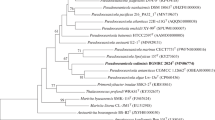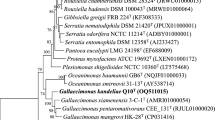Abstract
A Gram-stain negative, rod-shaped, non-motile, strictly aerobic bacterium HK-28T was isolated from a mangrove sediment sample in Haikou city, Hainan Province, China. Strain HK-28T was able to grow at 10–45 °C (optimum 25–30 °C), pH 5.0–8.5 (optimum 6.0–7.0) and 0.5–12.0% (w/v) NaCl (optimum 1.0–3.0%, w/v). The major cellular fatty acids were C16:0, Summed Feature 8 (C18:1 ω7c and/or C18:1 ω6c), Summed Feature 3 (C16:1 ω7c and/or C16:1 ω6c), C17:0, C12:0 3-OH and C17:1ω8c. Ubiquinone-8 (Q-8) was the predominant respiratory quinone. The polar lipids consisted of diphosphatidylglycerol, phosphatidylglycerol, phosphatidylethanolamine, two unidentified aminophospholipids, four unidentified phospholipids, two unidentified glycolipid, an unidentified glycophospholipid, an unidentified aminolipid and an unidentified lipid. The DNA G+C content was 50.2 mol%. Accoroding to 16S rRNA gene sequence similarities, strain HK-28T shared 97.1 and 96.7% sequence similarities to the validly named species Gallaecimonas xiamenensis MCCC 1A01354T and Gallaecimonas pentaromativorans MCCC 1A06435T, respectively, and shared lower sequence similarities (< 92.0%) to all other genera. Phylogenetic analysis showed strain HK-28T was clustered with G. pentaromativorans MCCC 1A06435T and G. xiamenensis MCCC 1A01354T. Strain HK-28T showed low DNA–DNA relatedness with G. xiamenensis MCCC 1A01354T (28.3 ± 1.5%) and G. pentaromativorans MCCC 1A06435T (25.2 ± 2.4%). On the basis of phenotypic, chemotaxonomic and genotypic characteristics, strain HK-28T is considered to represent a novel species in the genus Gallaecimonas, for which the name Gallaecimonas mangrovi sp. nov. is proposed. The type strain is HK-28T (= KCTC 62177T = MCCC 1K03441).

Similar content being viewed by others
References
Bernardet JF, Nakagawa Y, Holmes B, Subcommittee on the taxonomy of Flavobacterium and Cytophaga-like bacteria of the International Committee on Systematics of Prokaryotes (2002) Proposed minimal standards for describing new taxa of the family Flavobacteriaceae and emended description of the family. Int J Syst Evol Microbiol 52:1049–1070
De Ley J, Cattoir H, Reynaerts A (1970) The quantitative measurement of DNA hybridization from renaturation rates. Eur J Biochem 12:133–142
Dong XZ, Cai MY (2001) Determination of biochemical properties. In: Dong XZ, Cai MY (eds) Manual for the systematic identification of General Bacteria. Science Press, Beijing, pp 370–398 (in Chinese)
Epstein SS (2013) The phenomenon of microbial uncultivability. Curr Opin Microbiol 16(5):636–642
Felsenstein J (1981) Evolutionary trees from DNA sequences: a maximum likelihood approach. J Mol Evol 17:368–376
Fitch WM (1971) Toward defining the course of evolution: minimum change for a specific tree topology. Syst Zool 20:406–416
Huß VAR, Festl H, Schleifer KH (1983) Studies on the spectrophotometric determination of DNA hybridization from renaturation rates. Syst Appl Microbiol 4:184–192
Kaeberlein T, Lewis K, Epstein SS (2002) Isolating “uncultivable” microorganisms in pure culture in a simulated natural environment. Science 296:1127–1129
Kates M (1986) Techniques of lipidology. isolation, analysis and identification of lipids, 2nd edn. Elsevier, Amsterdam
Kimura M (1980) A simple method for estimating evolutionary rates of base substitutions through comparative studies of nucleotide sequences. J Mol Evol 16:111–120
Komagata K, Suzuki K (1987) Lipid and cell-wall analysis in bacterial systematics. Method Microbiol 19:161–207
Kumar S, Stecher G, Tamura K (2016) MEGA7: molecular evolutionary genetics analysis version 7.0 for bigger datasets. Mol Biol Evol 33:1870–1874
Mesbah M, Whitman WB (1989) Measurement of deoxyguanosine/thymidine ratios in complex mixtures by high-performance liquid chromatography for determination of the mole percentage guanine + cytosine of DNA. J Chromatogr A 479:297–306
Minnikin DE, Odonnell AG, Goodfellow M, Alderson G, Athalye M, Schaal A, Parlett JH (1984) An integrated procedure for the extraction of bacterial isoprenoid quinones and polar lipids. J Microbiol Methods 2:233–241
Nichols D, Cahoon N, Trakhtenberg EM, Pham L, Mehta A et al (2010) Use of ichip for high-throughput in situ cultivation of ‘‘uncultivable’’ microbial species. Appl Environ Microbiol 76:2445–2450
Rodríguez-Blanco A, Vetion G, Escande ML, Delille D, Ghiglione JF (2010) Gallaecimonas pentaromativorans gen. nov., sp. nov., a bacterium carrying 16S rRNA gene heterogeneity and able to degrade high-molecular-mass polycyclic aromatic hydrocarbons. Int J Syst Evol Microbiol 60:504–509
Saitou N, Nei M (1987) The neighbor-joining method: a new method for reconstructing phylogenetic trees. Mol Biol Evol 4:406–425
Shen P, Chen XD (2008) Experiment of Microbiology. Higher Education Press, Beijing (English translation)
Sun C, Wang RJ, Su Y, Fu G, Zhao Z et al (2017) Hyphobacterium vulgare gen. nov., sp. nov., a novel alphaproteobacterium isolated from seawater. Int J Syst Evol Microbiol 67(5):1169–1176
Tindall BJ (1990) Lipid composition of Halobacterium lacusprofundi. FEMS Microbiol Lett 66:199–202
Wang JN, Lai QL, Duan X, Fu YY, Wang LP et al (2013) Gallaecimonas xiamenensis sp. nov., isolated from seawater. Int J Syst Evol Microbiol 63:930–933
Weisburg WG, Barns SM, Pelletier DA, Lane DJ (1991) 16S ribosomal DNA amplification for phylogenetic study. J Bacteriol 173:697–703
Yoon SH, Ha SM, Kwon S, Lim J, Kim Y et al (2017) Introducing EzBioCloud: a taxonomically united database of 16S rRNA and whole genome assemblies. Int J Syst Evol Microbiol 67:1613–1617
Zhong ZP, Liu Y, Wang F, Zhou YG, Liu HC et al (2016) Planktosalinus lacus gen. nov., sp. nov., a member of the family Flavobacteriaceae isolated from a salt lake. Int J Syst Evol Microbiol 66:2084–2089
Zhu XF (2011) Modern experimental technique of microbiology. Zhejiang University Press, Hangzhou (English translation)
Acknowledgements
This work was supported by the Natural Science Foundation of Zhejiang Province of China (LQ18C010001), National Natural Science Foundation of China (41776168), Ningbo Sci & Tech Project for Common Wealth (2017C10016), National 111 Project of China, Li Dak Sum Yip Yio Chin Kenneth Li Marine Biopharmaceutical Development Fund and K.C.Wong Magna Fund in Ningbo University. S.S.E. was sponsored by the Chinese National Recruitment Program of Global Experts (1000 Talents Program).
Author information
Authors and Affiliations
Corresponding authors
Ethics declarations
Conflict of interest
The authors declare there are no conflicts of interest.
Additional information
The GenBank/EMBL/DDBJ accession number for the 16S rRNA gene sequence of strain HK-28T is MF800856.
Electronic supplementary material
Below is the link to the electronic supplementary material.
Rights and permissions
About this article
Cite this article
Zhang, WY., Yuan, Y., Su, DQ. et al. Gallaecimonas mangrovi sp. nov., a novel bacterium isolated from mangrove sediment. Antonie van Leeuwenhoek 111, 1855–1862 (2018). https://doi.org/10.1007/s10482-018-1076-y
Received:
Accepted:
Published:
Issue Date:
DOI: https://doi.org/10.1007/s10482-018-1076-y




